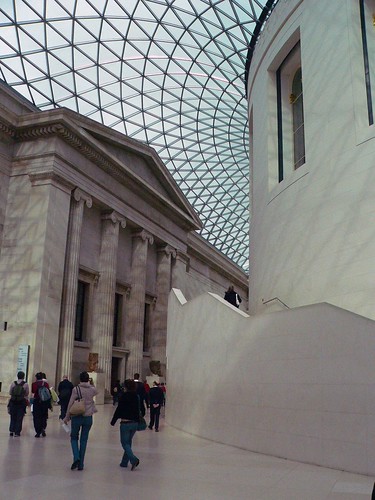
Wednesday, April 5, 2006: - Sorry to interrupt my commentary for so long but the internet was, as my British friends would say, a bit dodgy on Sunday and we returned too late Monday and was too tired to write Tuesday after touring all day.
Sunday we spent all morning at the
 rvice jobs that even asking a bus driver is pointless because they don't seem to know any routes other than their own. Anyway, as you can guess, I was racing around shooting pictures until my shutter finger was almost worn out. I love mosaics so I was thrilled to find
rvice jobs that even asking a bus driver is pointless because they don't seem to know any routes other than their own. Anyway, as you can guess, I was racing around shooting pictures until my shutter finger was almost worn out. I love mosaics so I was thrilled to find 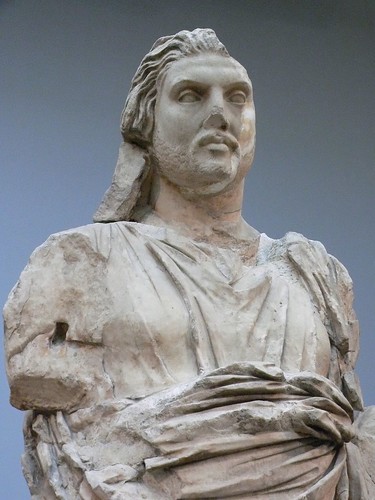 the stairway with mosaics from Halacarnassus all the way up the walls. I also didn't realize that there was anything left of the Tomb of Mausalus at Halicarnassus so was thrilled to see the large statue of Mausalus and his warrior queen Artemisia (she was the only female ship's captain serving the Persian king Xerxes at the battle of
the stairway with mosaics from Halacarnassus all the way up the walls. I also didn't realize that there was anything left of the Tomb of Mausalus at Halicarnassus so was thrilled to see the large statue of Mausalus and his warrior queen Artemisia (she was the only female ship's captain serving the Persian king Xerxes at the battle of 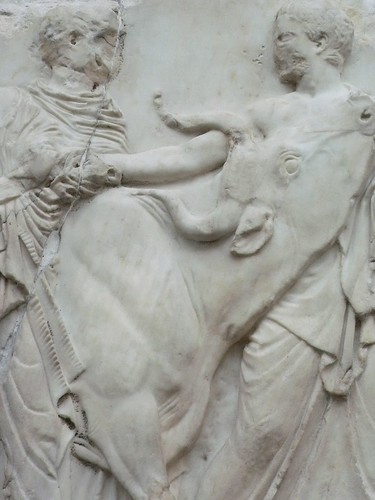
Of course I made a point of seeing the
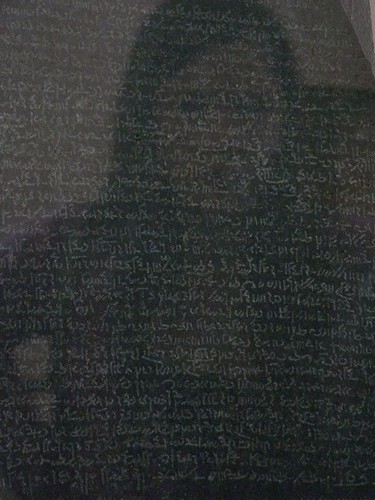 original picture was about. I also made a point of finding the Rosetta Stone. I walked past it twice before I realized it was in the case that everyone was clustered around. I tried to get a picture of the surface of it without all the visitor reflections but I realized that it might be more interesting if I caught this reflection that one's imagination could presuppose was Cleopatra gazing b ack at us from antiquity.
original picture was about. I also made a point of finding the Rosetta Stone. I walked past it twice before I realized it was in the case that everyone was clustered around. I tried to get a picture of the surface of it without all the visitor reflections but I realized that it might be more interesting if I caught this reflection that one's imagination could presuppose was Cleopatra gazing b ack at us from antiquity.
I managed to photograph what I thought was the most interesting of the Greek, Roman, and Near East exhibits and started on the Egyptian exhibits when I had to report back to the main hall to meet my sister for lunch. I love the Greco-Roman mummy portraits from the Fayum region of Egypt and was lucky enough to see the beautifully painted sarcophagus of Artemidorus. I had watched a BBC program where the mummy was CAT-scanned during a study of it and never thought I would actually get to see Artemidorous' handsome visage in person.
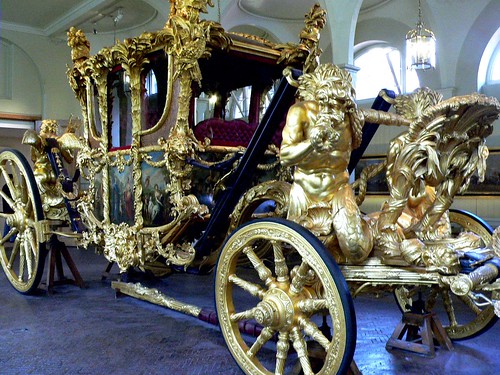 We had to head over to the Royal Mews at
We had to head over to the Royal Mews at  royal processions. Of course the coronation coach was the spectacular grand finale.
royal processions. Of course the coronation coach was the spectacular grand finale.Walking back to the Victoria Memorial so I could finish photographing it, I took a nose dive on the uneven paving stones along the side of
 Monday, we took the train to Swanley where my friend Richard picked us up and drove us all around
Monday, we took the train to Swanley where my friend Richard picked us up and drove us all around 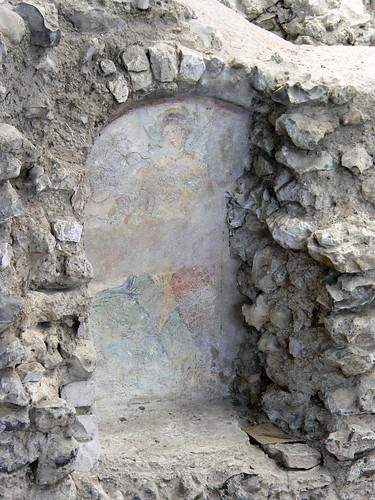 building. Later, rooms heated by an underfloor hot air system called a hypocaust were added as well. Finally, in the mid-fourth century, a lavish mosaic-decorated apsed dining room was constructed. The site is considered an important example of religious change that occured during this period of Roman occupation. A painting of two water nymphs, creatures that played an important role in pagan mythology, is still visible in the "Deep Room". While fragments of paintings of Christians in prayer were also found at the site.
building. Later, rooms heated by an underfloor hot air system called a hypocaust were added as well. Finally, in the mid-fourth century, a lavish mosaic-decorated apsed dining room was constructed. The site is considered an important example of religious change that occured during this period of Roman occupation. A painting of two water nymphs, creatures that played an important role in pagan mythology, is still visible in the "Deep Room". While fragments of paintings of Christians in prayer were also found at the site.Next, we toured a beautiful medieval manor house at Ingtham Mote. This moated structure was built in 1320. The original owner is now thought to be Isolde Inge later called St Pere. Until recently, Sir Thomas Cawne, a knight who
 may have fought with the Black Prince at Crecy, was credited with the construction.
may have fought with the Black Prince at Crecy, was credited with the construction.Historians attribute its amazing state of preservation to the fact that none of its residents were particularly ambitious, seemingly satisfied to fulfill their roles as squires, sheriffs, or courtiers. That's not to say the house didn't witness at least a little intrigue. One of the subsequent owners, William Haute, joined Jack Cade and other lords, magnates and people of Kent to issue the The Complaint of the Poor Commons of Kent against Henry VI. Haute's son (or grandson) Richard, later joined in a rebellion against Richard III. So it may seem like a miracle that Ingtham's closest brush with destruction is said to have occurred during the English Civil War when Cromwell's soldiers, who had planned to loot Ingtham Mote, lost their way and ended up sacking another estate instead. I'm sure each visitor to the house is truly grateful! More pictures...
 We topped off our day with a visit to the spectacularly beautiful
We topped off our day with a visit to the spectacularly beautiful "Wonderful in manifold glories are the great castle visions of Europe; Windsor from the Thames, Warwick or Ludlow from their riversides, Conway or Caernarvon from the sea, Amboise from the Loire, Aigues Mortes from the lagoons, Carcassonne, Councy, Falaise and Chateau Gaillard - beautiful as they are and crowned with praise, are not comparable in beauty as with Leeds, beheld among the waters on an autumnal evening when the bracken is golden and there is a faint blue mist among the trees - the loveliest castle, as thus beheld, in the whole world." - Lord Conway
Originally the Saxon manor named Esledes, Leeds Castle was a stronghold of the Saxon royal family beginning with the reign of Ethelbert IV (856-860). It was later conveyed to the powerful house of Godwin by Edward the Confessor but following the Norman conquest it was granted to a cousin of William II Rufus, Hamo de Crevecoeur. When the de Crevecoeur family fortunes waned following the battle of Evesham in 1265, the castle passed to Sir Roger de Leyburn. His son later conveyed the castle to Edward I and his queen, Eleanor of Castile. From that point for the next three hundred years, Leeds Castle remained a royal home.
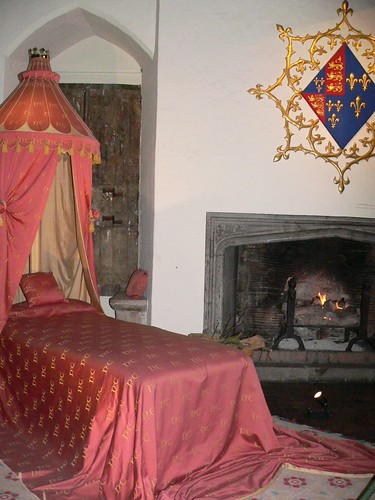 This canopied day bed in Queen Catherine de Valois' chamber is topped by a golden crown to denote the eminence of its royal occupant. The queen used this room to receive adviers, courtiers and petitioners. After the death of her husband, King Henry V, she fell in love with the Welsh Clerk of her Wardrobe, Owen Tudor. They were discovered and imprisoned but the Queen was subsequently released. When Tudor escaped, they secretly married and Catherine gave birth to a son, Edmund, who became the father of Henry VII,
This canopied day bed in Queen Catherine de Valois' chamber is topped by a golden crown to denote the eminence of its royal occupant. The queen used this room to receive adviers, courtiers and petitioners. After the death of her husband, King Henry V, she fell in love with the Welsh Clerk of her Wardrobe, Owen Tudor. They were discovered and imprisoned but the Queen was subsequently released. When Tudor escaped, they secretly married and Catherine gave birth to a son, Edmund, who became the father of Henry VII, founder of the Tudor dynasty.
founder of the Tudor dynasty.The queen's bath was canopied with white damask and was designed to be easily dismantled so it could be moved to another residence when the queen relocated to another palace or outdoors in good weather.
Hot baths were still very popular during the early Middle Ages and most towns, as late as the mid-1200s had public bathhouses.
"By the mid-1300s, only the very wealthy could afford firewood for hot water in the winter. The rest of the population was forced to be dirty most of the time." - medieval-life.net

Henry the VIII refurbished Leeds Castle early in his marriage to Catherine of Aragon and the room termed the Queen's Gallery reflects their relationship in its ragstone fireplace emblazoned with the coat of arms of the House of Lancaster and the castle of Castile as well as the pomegranates of Aragon. However, Henry spent little time there after their separation. But, the faint play of light on a shadowed bust of Henry in this room gave me the feeling his spirit still frequents these halls.

A number of portraits and busts of the Tudor dynasty adorn Leeds Castle but I was particularly struck by a portrait labeled as unidentified but attributed to Marcus Gheeraerts the Younger (1561-1635). Gheeraerts painted a number of portraits of Queen Elizabeth I but for some reason, art historians are hesitant to identify this portrait as one of them even though the lady wears a white dress (Elizabeth's favorite colors were white and black), she wears a crown upon auburn hair, and is lavishly adorned with pearls (another symbol used frequently by Elizabeth to emphasize her personnae as the "Virgin Queen".
Perhaps I was simply pleased to take my own photo of a potential Queen Elizabeth portrait in a white gown that I can use as I please after locking horns with the National Portrait Gallery over the noncommerical, educational use of an image of a similar portrait of Elizabeth in their collection. See Copyright Wars
 Other artwork at Leeds includes this 14th century Burgundian limestone sculpture of St. Barbara, the patron saint of artillery who lived in the 4th century CE. She cradles a tower in her left hand that symbolizes her imprisonment to discourage suitors.
Other artwork at Leeds includes this 14th century Burgundian limestone sculpture of St. Barbara, the patron saint of artillery who lived in the 4th century CE. She cradles a tower in her left hand that symbolizes her imprisonment to discourage suitors."According to legend, Saint Barbara was the extremely beautiful daughter of a wealthy heathen named Dioscorus, who lived near Nicomedia in Asia Minor. Because of her singular beauty and fearful that she be demanded in marriage and taken away from him, he jealously shut her up in a tower to protect her from the outside world.
Shortly before embarking on a journey, he commissioned a sumptuous bathhouse to be built for her, approving the design before he departed. Barbara had heard of the teachings of Christ, and while her father was gone spent much time in contemplation. From the windows of her tower she looked out upon the surrounding countryside and marveled at the growing things; the trees, the animals and the people. She decided that all these must be part of a master plan, and that the idols of wood and stone worshipped by her parents must be condemned as false. Gradually she came to accept the Christian faith.
As her belief became firm, she directed that the builders redesign the bathhouse her father had planned, adding another window so that the three windows might symbolize the Holy Trinity.
When her father returned, he was enraged at the changes and infuriated when Barbara acknowledged that she was a Christian. He dragged her before the perfect of the province, who decreed that she be tortured and put to death by beheading. Dioscorus himself carried out the death sentence. On his way home he was struck by lightening and his body consumed." - The Legend of St. Barbara
Another interesting sculpture is the carved oak figure of a laughing crusader at the head of the spiral staircase leading to the Gloriette Landing. The 16th-century style oak staircase was actually built by Armand Albert Rateau in 1929 but the figure gripping his sword and shield blend nicely with the genuine period art throughout the house. One concession is made to modern interpretation however. The crusader's shield bears a grinning lion sticking its tongue out as if the crusader was a refugee from Monty Python's dubious heroes in "The Holy Grail".
 Another example of "faux period" design is the blue-panelled bedroom of Lady Baillie. Mrs. Wilson Filmer purchased the castle in 1924 when the Wykeham Martin family was forced to sell the estate to pay death duties and potential buyer, William Randolph Hearst, bowed out of the transaction. Lady Baillie, as she became known, hired interior designer Stephane Boudin to redecorate parts of the home. Boudin had joined the leading interior design firm in Paris, Maison Jansen, just the year before. He eventually became president of the company whose client list included the Duke and Duchess of Windsor and Jacqueline Kennedy.
Another example of "faux period" design is the blue-panelled bedroom of Lady Baillie. Mrs. Wilson Filmer purchased the castle in 1924 when the Wykeham Martin family was forced to sell the estate to pay death duties and potential buyer, William Randolph Hearst, bowed out of the transaction. Lady Baillie, as she became known, hired interior designer Stephane Boudin to redecorate parts of the home. Boudin had joined the leading interior design firm in Paris, Maison Jansen, just the year before. He eventually became president of the company whose client list included the Duke and Duchess of Windsor and Jacqueline Kennedy.Lady Baillie's bedroom was redesigned to emulate the Regence style of the early 18th century. Boudin installed blue boiserie with several doors concealed behind the azure panels. To reflect Lady Baillie's love of birds, Boudin placed bird-shaped
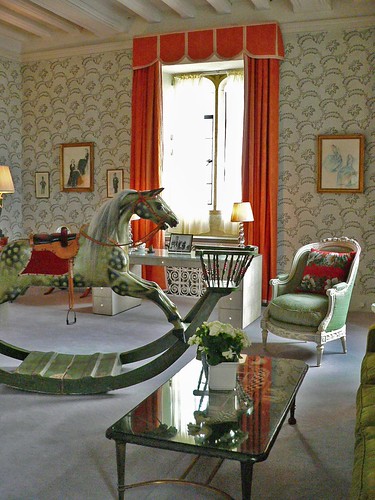 ceramic pieces around the room including pairs of famille rose cranes from the Qianlong period.
ceramic pieces around the room including pairs of famille rose cranes from the Qianlong period.One of Boudin's last commissions in the 1960s was to convert the bedroom that had once been used by Queen Catherine of Aragon to a boudoir. Again he used white bedding and woodwork to emphasize the size of the room but incorporated a homey warmth with country-style wallpaper and a playful Victorian rocking horse.
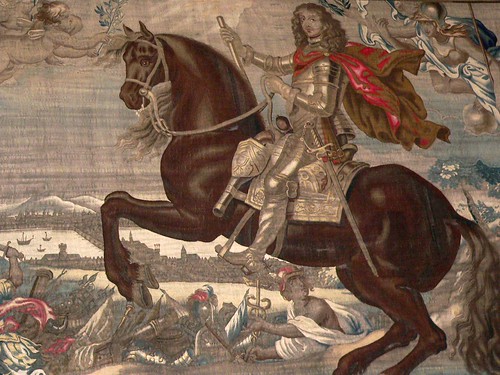 The Merry Monarch, King Charles II (so named because he fathered numerous illegitimate children, of whom he acknowledged fourteen, and was an avid patron of the arts), is the subject of this Flemish tapestry based on Abraham van Diepenbeke's illustrations for a book on horsemanship published in 1658. Traditionally, if a king, knight, or nobleman is represented in an equestrian image with both of the horse's front feet raised, this symbolized a death in battle. However, this is not the case for King Charles II. Although he was the target of the Rye House Plot, he and his brother, the Duke of York, escaped the angry Protestants enraged because Charles, a Protestant himself, would not support their Exclusion Bill that would remove his catholic brother from the legal succession. Later, Charles died suddenly of uremia, a clinical syndrome due to kidney dysfunction.
The Merry Monarch, King Charles II (so named because he fathered numerous illegitimate children, of whom he acknowledged fourteen, and was an avid patron of the arts), is the subject of this Flemish tapestry based on Abraham van Diepenbeke's illustrations for a book on horsemanship published in 1658. Traditionally, if a king, knight, or nobleman is represented in an equestrian image with both of the horse's front feet raised, this symbolized a death in battle. However, this is not the case for King Charles II. Although he was the target of the Rye House Plot, he and his brother, the Duke of York, escaped the angry Protestants enraged because Charles, a Protestant himself, would not support their Exclusion Bill that would remove his catholic brother from the legal succession. Later, Charles died suddenly of uremia, a clinical syndrome due to kidney dysfunction."When he knew he was dying and in great secrecy, a priest, Father John Huddleston, was summoned to his bedside. Charles was admitted into the Catholic Church and received the last rites. He was succeeded by the Duke of York, who became James II in England and Ireland, and James VII in Scotland." - Wikipedia
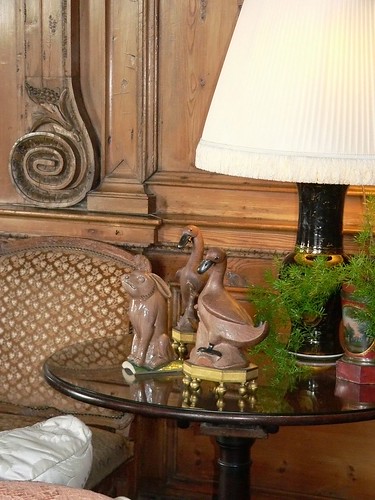
The Thorpe Hall Room features warm, ornately carved-pine panelling rescued from a coat of green paint and brought to Leeds from Thorpe Hall near Peterborough. It was originally designed in 1653 by Peter Mills, who, together with Sir Christopher Wren, famous architect of St. Paul's Cathedral, supervised the rebuilding of London after the Great Fire of 1666. Once again we find birds as accent pieces. This time they are 19th century Chinese biscuit-ware ducks. They are accompanied by a Chinese ridge tile rabbit.
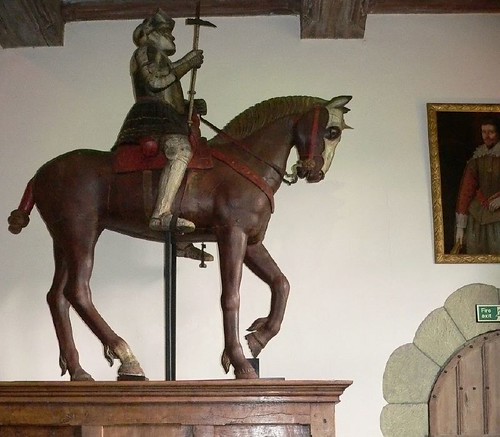 Leeds Castle is also home to the earliest known equestrian statue in the history of English sculpture - the Lumley Horseman. This carved oak figure was originally commissioned in memory of King Edward III by the 7th Lord Lumley for his castle in County Durham. The artist is not known but is thought to have been a Flemish sculptor working in England.
Leeds Castle is also home to the earliest known equestrian statue in the history of English sculpture - the Lumley Horseman. This carved oak figure was originally commissioned in memory of King Edward III by the 7th Lord Lumley for his castle in County Durham. The artist is not known but is thought to have been a Flemish sculptor working in England.Wood carvers of this period often used tints of red, blue, green or white to add detail to their work. Bands of carvers would often travel from church to church embellishing altars and choir screens. One such carver was probably comandeered for this commission. - See the history of woodcarving
One of the contestants in the Hundred Years War, Edward III was the founder of the chivalrous " Order of the Garter, allegedly as a result of an incident when a lady, with whom he was dancing at a court ball, dropped an item of intimate apparel (possibly a sanitary belt, though sources describe it as being made of velvet). Gallantly picking it up to assuage her embarrassment, Edward tied it around his own leg, and remarked Honi soit qui mal y pense ('Shame on him who thinks evil of it'), which became the motto of the Order of the Garter." - Wikipedia
He also fathered the famous "Black Prince", Edward of Woodstock. Like Alexander the Great, Edward demonstrated his courage and military talent at the age of 16 at the Battle of Crecy.
As the light began to fade toward sunset, Richard took us to
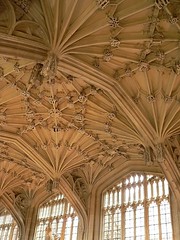 Yesterday, we took a tour bus up to
Yesterday, we took a tour bus up to
4 comments:
I love London
I recently came accross your blog and have been reading along. I thought I would leave my first comment. I dont know what to say except that I have enjoyed reading. Nice blog. I will keep visiting this blog very often.
Alisha
http://sketchingdrawing.com
Remarkable! You actually got to see Shakespeare's birthplace! Can't wait until I see more of your travels! Israel and Egypt especially!
living can be attributed to journeying, as we live our lives we journey through different streets, plazas, avenues and highways..some are rocky some are narrow and some are straight. But no matter what issues we encounter on our way of living our lives, lets not forget to appreciate the scenery and what life has to offer..let us not stop from learning. Great Article!
john_Arbuckle
Post a Comment